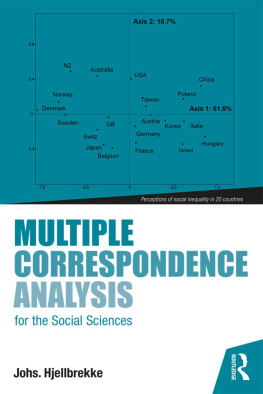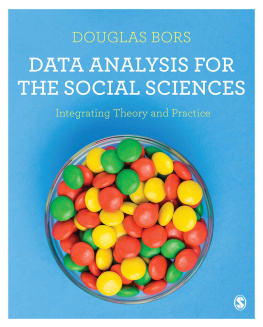MULTIPLE CORRESPONDENCE ANALYSIS FOR THE SOCIAL SCIENCES
Multiple correspondence analysis (MCA) is a statistical technique that first and foremost has become known through the work of the late Pierre Bourdieu (19302002). This book will introduce readers to the fundamental properties, procedures and rules of interpretation of the most commonly used forms of correspondence analysis. The book is written as a non-technical introduction, intended for the advanced undergraduate level and onwards.
MCA represents and models data sets as clouds of points in a multidimensional Euclidean space. The interpretation of the data is based on these clouds of points. In seven chapters, this non-technical book will provide the reader with a comprehensive introduction and the needed knowledge to do analyses on his/her own: CA, MCA, specific MCA, the integration of MCA and variance analysis, of MCA and ascending hierarchical cluster analysis and class-specific MCA on subgroups. Special attention will be given to the construction of social spaces, to the construction of typologies and to group internal oppositions.
This is a book on data analysis for the social sciences rather than a book on statistics. The main emphasis is on how to apply MCA to the analysis of practical research questions. It does not require a solid understanding of statistics and/or mathematics, and provides the reader with the needed knowledge to do analyses on his/her own.
Johs. Hjellbrekke is Professor of Sociology at the University of Bergen, Norway, and Director of the Norwegian University Centre in Paris, FMSH. His research interests are in social stratification, class analysis, social mobility, the sociology of elites, geometric data analysis and statistical analysis of categorical data. Since 1995, he has taught courses in multiple correspondence analysis at more than 15 different universities.
MULTIPLE CORRESPONDENCE ANALYSIS FOR THE SOCIAL SCIENCES
Johs. Hjellbrekke
First published 2019
by Routledge
2 Park Square, Milton Park, Abingdon, Oxon OX14 4RN
and by Routledge
711 Third Avenue, New York, NY 10017
Routledge is an imprint of the Taylor & Francis Group, an informa business
2019 Johs. Hjellbrekke
The right of Johs. Hjellbrekke to be identified as author of this work has been asserted by him in accordance with sections 77 and 78 of the Copyright, Designs and Patents Act 1988.
All rights reserved. No part of this book may be reprinted or reproduced or utilised in any form or by any electronic, mechanical, or other means, now known or hereafter invented, including photocopying and recording, or in any information storage or retrieval system, without permission in writing from the publishers.
Trademark notice : Product or corporate names may be trademarks or registered trademarks, and are used only for identification and explanation without intent to infringe.
British Library Cataloguing-in-Publication Data
A catalogue record for this book is available from the British Library
Library of Congress Cataloging-in-Publication Data
Names: Hjellbrekke, Johs., author.
Title: Multiple correspondence analysis for the social sciences / Johs. Hjellbrekke.
Description: Abingdon, Oxon; New York, NY: Routledge, 2018. | Includes bibliographical references and index.
Identifiers: LCCN 2018010974 | ISBN 9781138699687 (hardcover) | ISBN 9781138699717 (pbk.) | ISBN 9781315516257 (ebook)
Subjects: LCSH: Social sciencesStatistical methods. | Correspondence analysis (Statistics)
Classification: LCC HA29 .H65445 2018 | DDC 519.5/37dc23
LC record available at https://lccn.loc.gov/2018010974
ISBN: 978-1-138-69968-7 (hbk)
ISBN: 978-1-138-69971-7 (pbk)
ISBN: 978-1-315-51625-7 (ebk)
Typeset in Bembo
by Deanta Global Publishing Services, Chennai, India
To Harald Hjellbrekke (19212012)
This is a book about multiple correspondence analysis, or MCA, a statistical technique for uncovering latent structures in a large table or a matrix. Among social scientists, MCA is first and foremost known through the works of the late Pierre Bourdieu (19302002). But this is neither a book in statistics, nor one that is primarily intended for researchers within the Bourdieusian school of sociology.
The text is based on a series of lectures that have evolved over almost 25 years. What started with three introductory lectures at the Department of Sociology, University of Bergen, in the spring of 1994, became a full six-week graduate course at the Department of Sociology, UC Berkeley, in the spring of 2008. New material on class-specific MCA was added in 2011, and a more comprehensive course goes further into the family of geometric statistical techniques.
The book could therefore have been much longer, gone into the finer details and also covered other variants of, and traditions within, MCA. But that book would most likely also overshoot its intended target group. Having taught MCA to students at various universities, Ive come to the conclusion that there is both room and need for an introductory text, intended for students in the social sciences who have little or no background in statistics. Readers who expect a book in mathematical statistics are therefore warned: You will have to look elsewhere, but many of the more advanced books that I would recommend are referred to in the text.
Hopefully, for social science students, this book can fill parts of the (pedagogical) gap in the existing literature. The focus is on giving a basic introduction to, and understanding of, MCA, and on how to apply MCA in the analysis of practical research questions. The number of equations is kept at a minimum, while at the same time providing the reader with an elementary knowledge about how MCA works. Students with a basic course in statistics for the social sciences should have few problems with following the presentation.
The main software used in this book is SPAD, Systme pour lanalyse des donnes (System for data analysis), developed by the French company Coheris. Other statistical software packages have good modules for doing MCA, but in my opinion, none of them are as good as SPAD. SPAD exists in French and English versions, and is both powerful and user-friendly.
Finally, and as already emphasized, this is not a book about Bourdieu and MCA. First, that book is already published in France (Lebaron & Le Roux 2015). Second, MCA should also be of interest and value to researchers who dont regard themselves as inspired by Bourdieus theory of fields. Third, readers who are inspired by Bourdieus work and interested in MCA are wise to keep in mind the words of the late Henry Rouanet: In the analysis of questionnaires, doing correspondence analyses is not enough to do analyses la Bourdieu.
More than 25 years ago, Espen Aarseth, now at IT University Copenhagen, showed me a graph over a cup of coffee in Bergen: Take a look at this. Doesnt this look interesting? Its a correspondence analysis. I fully agreed. Thanks to Espen, I got in touch with Daniel Apollon, also at the University of Bergen, who had written a magnificent statistical software program, Analytica. Daniel gave it to me free of charge, and over the next three years, he would have the answers to quite a few of my questions about MCA and data analysis. These were my first steps into a hitherto unknown territory, and I owe both Espen and Daniel a great thanks. It changed the way I thought about both statistics and sociology, and also the relation between these two disciplines.




